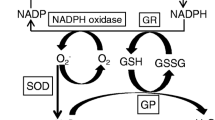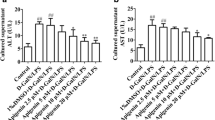Abstract
The oral administration of proline, one of the non-essential amino acids, has been shown to effectively protect the liver from d-galactosamine (GalN)-induced liver injury and to improve the survival rate. The aim of this study was to investigate the mechanism of this protective action of proline. We paid particular attention to the effect of proline on inflammatory activation, regenerative response, and the associated signal transduction in the liver. Male Fischer rats received intraperitoneal injections of GalN (1.4 g/kg) with or without the oral administration of proline (2 g/kg) 1 h before GalN treatment. Liver pathology, plasma indices of inflammation, and the level of proliferative marker in the liver were monitored. The hepatic activation of interleukin-6 (IL-6)/signal transducer and activator of transcription (STAT)-3 pathway, which is downstream of tumor necrosis factor (TNF)-α/nuclear factor-κB, was also studied. GalN induced massive inflammatory expansion in the liver, leading to a high death rate (60 %) more than 72 h after the treatment. Proline administration significantly suppressed inflammatory infiltration in the live after 48 h, which was accompanied by depletion of plasma TNF-α, glutamic oxaloacetic transaminase, and glutamic pyruvic transaminase. The mRNA expression of histone H3, a marker of proliferation, was significantly upregulated in the liver of proline-treated animals. Furthermore, IL-6/STAT-3 pathway, an anti-inflammatory and regenerative signaling pathway, was strongly activated prior to these observations, with the upregulated expression of downstream genes. These results suggest that the tissue-protective mechanism of proline involves the early activation of IL-6/STAT-3 pathway in the liver, with subsequent activation of the regenerative response and suppression of massive inflammatory activation.





Similar content being viewed by others
Abbreviations
- GalN:
-
d-Galactosamine
- IL-6:
-
Interleukin-6
- STAT3:
-
Signal transducer and activator of transcription 3
- TNF-α:
-
Tumor necrosis factor-α
- NF-κB:
-
Nuclear factor kappa B
- GOT:
-
Glutamic oxaloacetic transaminase
- GPT:
-
Glutamic pyruvic transaminase
- LEC rat:
-
Long Evans Cinnamon rat
- SDS:
-
Sodium dodecyl sulfate
- XIAP:
-
X-chromosome-linked inhibitor of apoptosis
- MAPK:
-
Mitogen-activated protein kinase kinase
- FLIP:
-
FLICE-inhibitory protein
- ROS:
-
Reactive oxygen species
- POX:
-
Proline oxidase
- FAD:
-
Flavine adenine dinucleotide
References
Adams E, Frank L (1980) Metabolism of proline and the hydroxyprolines. Annu Rev Biochem 49:1005–1061. doi:10.1146/annurev.bi.49.070180.005041
Ajinomoto Co., Inc. (1996) Japan Patent Kokai 1996-169063
Aldeguer X, Debonera F, Shaked A, Krasinkas AM, Gelman AE, Que X et al (2002) Interleukin-6 from intrahepatic cells of bone marrow origin is required for normal murine liver regeneration. Hepatology 35:40–48. doi:10.1053/jhep2002.30081
Chen Lf, Fischle W, Verdin E, Greene WC (2001) Duration of nuclear NF-kappaB action regulated by reversible acetylation. Science 293:1653–1657. doi:10.1126/science.1062374
Cressman DE, Greenbaum LE, DeAngelis RA, Ciliberto G, Furth EE, Poli V et al (1996) Liver failure and defective hepatocyte regeneration in interleukin-6-deficient mice. Science 274:1379–1383. doi:10.1126/science.274.5291.1379
Donald SP, Sun XY, Hu CA, Yu J, Mei JM, Valle D et al (2001) Proline oxidase, encoded by p53-induced gene-6, catalyzes the generation of proline-dependent reactive oxygen species. Cancer Res 61:1810–1815
Fujiyoshi M, Ozaki M (2011) Molecular mechanisms of liver regeneration and protection for treatment of liver dysfunction and diseases. J Hepatobiliary Pancreat Sci 18(1):13–22
Gloire G, Legrand-Poels S, Piette J (2006) NF-kappaB activation by reactive oxygen species: fifteen years later. Biochem Pharmacol 72:1493–1505. doi:10.1016/j.bcp.2006.04.011
Grün M, Liehr H, Rasenack U (1977) Significance of endotoxaemia in experimental “galactosamine-hepatitis” in the rat. Acta Hepatogastroenterol (Stuttg) 24:64–81
Haga S, Terui K, Zhang HQ, Enosawa S, Ogawa W, Inoue H et al (2003) Stat3 protects against Fas-induced liver injury by redox-dependent and -independent mechanisms. J Clin Invest 112:989–998. doi:10.1172/JCI200317970
Hagedorn CH, Phang JM (1983) Transfer of reducing equivalents into mitochondria by the interconversions of proline and delta 1-pyrroline-5-carboxylate. Arch Biochem Biophys 225:95–101. doi:10.1016/0003-9861(83)90010-3
Hawkins RL, Mori M, Inoue M, Torii K (1995) Proline, ascorbic acid, or thioredoxin affect jaundice and mortality in Long Evans cinnamon rats. Pharmacol Biochem Behav 52:509–515. doi:10.1016/0091-3057(95)00118-G
Itokazu Y, Segawa Y, Inoue N, Omata T (1999) D-galactosamine-induced mouse hepatic apoptosis: possible involvement with tumor necrosis factor, but not with caspase-3 activity. Biol Pharm Bull 22:1127–1130
Jirillo E, Caccavo D, Magrone T, Piccigallo E, Amati L, Lembo A et al (2002) The role of the liver in the response to LPS: experimental and clinical findings. J Endotoxin Res 8:319–327. doi:10.1177/09680519020080050501
Kirillova I, Chaisson M, Fausto N (1999) Tumor necrosis factor induces DNA replication in hepatic cells through nuclear factor kappaB activation. Cell Growth Differ 10:819–828
Kovalovich K, DeAngelis RA, Li W, Furth EE, Ciliberto G, Taub R (2000) Increased toxin-induced liver injury and fibrosis in interleukin-6-deficient mice. Hepatology 31:149–159. doi:10.1002/hep510310123
Kovalovich K, Li W, DeAngelis R, Greenbaum LE, Ciliberto G, Taub R (2001) Interleukin-6 protects against Fas-mediated death by establishing a critical level of anti-apoptotic hepatic proteins FLIP, Bcl-2, and Bcl-xL. J Biol Chem 276:26605–26613. doi:10.1074/jbc.M100740200
Lee H, Herrmann A, Deng JH, Kujawski M, Niu G, Li Z et al (2009) Persistently activated Stat3 maintains constitutive NF-kappaB activity in tumors. Cancer Cell 15:283–293. doi:10.1016/j.ccr.2009.02.015
Li W, Liang X, Kellendonk C, Poli V, Taub R (2002) STAT3 contributes to the mitogenic response of hepatocytes during liver regeneration. J Biol Chem 277:28411–28417. doi:10.1074/jbc.M202807200
Li W, Liang X, Leu JI, Kovalovich K, Ciliberto G, Taub R (2001) Global changes in interleukin-6-dependent gene expression patterns in mouse livers after partial hepatectomy. Hepatology 33:1377–1386. doi:10.1053/jhep2001.24431
MacDonald JR, Beckstead JH, Smuckler EA (1987) An ultrastructural and histochemical study of the prominent inflammatory response in d (+)-galactosamine hepatotoxicity. Br J Exp Pathol 68:189–199
Matsumoto T, O’Malley K, Efron PA, Burger C, McAuliffe PF, Scumpia PO et al (2006) Interleukin-6 and STAT3 protect the liver from hepatic ischemia and reperfusion injury during ischemic preconditioning. Surgery 140:793–802. doi:10.1016/j.surg.2006.04.010
Moh A, Iwamoto Y, Chai GX, Zhang SS, Kano A, Yang DD et al (2007) Role of STAT3 in liver regeneration: survival, DNA synthesis, inflammatory reaction and liver mass recovery. Lab Invest 87:1018–1028. doi:10.1038/labinvest.3700630
Phang JM (1985) The regulatory functions of proline and pyrroline-5-carboxylic acid. Curr Top Cell Regul 25:91–132
Schuringa JJ, Dekker LV, Vellenga E, Kruijer W (2001) Sequential activation of Rac-1, SEK-1/MKK-4, and protein kinase Cdelta is required for interleukin-6-induced STAT3 Ser-727 phosphorylation and transactivation. J Biol Chem 276(29):27709–27715. doi:10.1074/jbc.M009821200
Singh A, Jayaraman A, Hahn J (2006) Modeling regulatory mechanisms in IL-6 signal transduction in hepatocytes. Biotechnol Bioeng 95(5):850–862. doi:10.1002/bit.21026
Teoh N, Leclercq I, Pena AD, Farrell G (2003) Low-dose TNF-alpha protects against hepatic ischemia-reperfusion injury in mice: implications for preconditioning. Hepatology 37(1):118–128. doi:10.1053/jhep2003.50009
Takeda K, Clausen BE, Kaisho T, Tsujimura T, Terada N, Förster I et al (1999) Enhanced Th1 activity and development of chronic enterocolitis in mice devoid of Stat3 in macrophages and neutrophils. Immunity 10:39–49. doi:10.1016/S1074-7613(00)80005-9
Taub R (2003) Hepatoprotection via the IL-6/Stat3 pathway. J Clin Invest 112:978–980. doi:10.1172/JCI200319974
Wu G, Bazer FW, Burghardt RC, Johnson GA, Kim SW, Knabe DA, Li P, Li X, McKnight JR, Satterfield MC, Spencer TE (2011) Proline and hydroxyproline metabolism: implications for animal and human nutrition. Amino Acids 40(4):1053–1063. doi:10.1007/s00726-010-0715-z
Vemura RP, Aragona E, Gupta S (1992) Analysis of hepatocelluar proliferation: study of archival liver tissue is facilitated by an endogenous marker of DNA replication. Hepatology 16:968–973
Xu Y, Bialik S, Jones BE, Iimuro Y, Kitsis RN, Srinivasan A et al (1998) NF-kappaB inactivation converts a hepatocyte cell line TNF-alpha response from proliferation to apoptosis. Am J Physiol 275(4 Pt 1):C1058–C1066
Acknowledgments
This study was supported by a private fund from Ajinomoto Co., Inc. The authors thank Dr. Koichi Ishii, Mr. Katsunori Kobayashi, Dr. Ikuko Sasahara, D.V.M., and Ms. Miwako Yamanoue for technical assistance and significant support.
Conflict of interest
This study was supported by a private fund from Ajinomoto Co., Inc. All authors are employee of Ajinomoto Co., Inc., which has published a large number of papers about the function of amino acids, strenuously doing basic research. No patent has been applied based on the research of this manuscript.
Author information
Authors and Affiliations
Corresponding author
Rights and permissions
About this article
Cite this article
Obayashi, Y., Arisaka, H., Yoshida, S. et al. Proline protects liver from d-galactosamine hepatitis by activating the IL-6/STAT3 survival signaling pathway. Amino Acids 43, 2371–2380 (2012). https://doi.org/10.1007/s00726-012-1317-8
Received:
Accepted:
Published:
Issue Date:
DOI: https://doi.org/10.1007/s00726-012-1317-8




